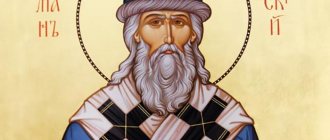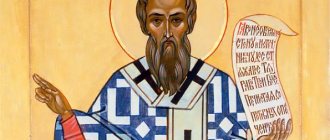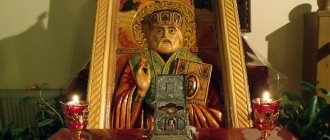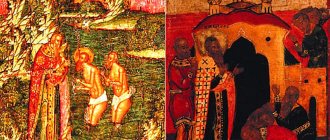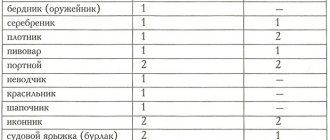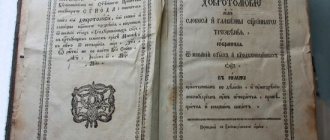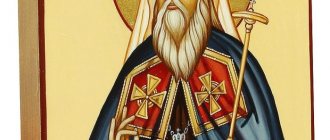Saint Gury, known in the world as Gregory Rugotin, the first Archbishop of Kazan, is a model of mercy and an example to follow for many Orthodox believers. Prayer to Gury the Kazan Martyr , offered to him in his hour of illness and spiritual sorrow, helps Christians strengthen their faith and find their true path in earthly life.
Life of a Saint
Memorial Days:
- July 15 (movable) - Cathedral of Tver Saints
- July 3 – Transfer of relics
- October 17 - Finding of relics. Cathedral of Kazan Saints
- December 18
Born into a poor noble family, the young man was devout from a young age. Therefore, slandered by his enemies for a crime he did not commit, and imprisoned in a pit, the future saint resigned himself to his fate, thanking God for every day he lived. Moreover, Guriy Kazansky began to write the alphabet and gave them to the poor.
Two years later, the saint climbed out of the pit with the icon of the Mother of God and went to the monastery to serve the Lord, becoming a monk. Later, Gury, a deep believer in the power of the Lord, becomes the abbot of the monastery, performing prayers and delighting those around him with love, patience and diligence. Under his wise leadership, dozens of churches and four monasteries appeared in Rus', where, even after the death of the archbishop, prayers of gratitude were offered to Saint Gury of Kazan, glorifying his wisdom and holiness.
Iconography
Icon painters immortalized the image of the venerable elder in church icons. The saint, as a rule, is depicted in the clothes of an archbishop, holding the Holy Gospel in one hand. Indeed, during his lifetime, Gury, with the words of the Holy Scriptures, converted people to Christianity. In some church images, the monk holds in one hand an icon depicting the Mother of God and the Holy Child, and with the other hand blesses the believers. The face of the holy archbishop can be seen in many Kazan churches.
How does prayer help Gury Kazansky?
On memorial days, all Orthodox believers remember a man who managed to glorify the Christian faith in new lands. Many believers go in crowds to the Kazan Annunciation Cathedral in Kazan, where the relics of St. Guria are located, to ask him for help in strengthening faith in the Lord.
Prayers to the holy martyr also help at that hour when your family needs help, when there is no harmony and harmony in it. A husband and wife who are on the verge of divorce can also turn to Gury Kazansky to reconcile them.
The words of prayer to Guriy of Kazan also heal from illnesses, in particular, with severe headaches and eye diseases.
GURI
Saints Gury and Barsanuphius of Kazan. Fragment of the chromolithograph “Saints for October”. Beginning XX century (GLM)
Saints Gury and Barsanuphius of Kazan. Fragment of the chromolithograph “Saints for October”. Beginning XX century (GLM) G. is depicted in a phelonion, an omophorion and a miter, with an elongated beard, which is noted in the iconographic originals of the 17th - early. XX century under October 4: “Guriy sed, brada aki Vlasieva” (original by Nicodemus of Siysky last quarter of the 17th century - BAN. Collection of the Arkhangelsk DS. No. 205. L. 79 vol.); “... in the likeness of a gray head, a brad like Basil of Caesarea, in a hat, in an omophorion, in the hands of a Gospel, a saint’s robe” (Filimonov. Iconographic original. P. 166; Bolshakov. Iconographic original. P. 36); “Guriy gray, brada aka Vlasiev, and inde Basil of Caesarea, in a hat with a cherub, a saint’s robe, azure, under a cormorant, amphora and the Gospel” (Pomeranian manuscript ca. 1848 - BAN. Druzhin. No. 981. L. 90 volume .). As in the description of the appearance of the Kazan saints Herman and Barsanuphius, the originals are about (Fartusov. Guide to the Writing of Icons. P. 36).
According to the description of the ancient (?) double-sided altarpiece “Tikhvin Icon of the Mother of God - Saints Gury and Barsanuphius of Kazan” from the Cathedral of the Kazan Transfiguration Monastery (not preserved), “Guriy is taller than Barsanuphius. His face is distinguished by meekness; brown eyes look openly; the beard is thick, long, almost all gray; the mustache almost coincides with the top of the beard and covers the mouth. Gury’s attractive appearance was also matched by his moral qualities” (Kremlevsky A., priest St. Gury of Kazan // Izvestia on the Kazakh diocese. Kaz., 1905. No. 29. Unofficial department. P. 953-954). The preserved wooden, partially covered with silver, long crutch-staff with a large semicircular handle, on which G. leaned when performing the cell rule (now in the church of the princes Theodore, David and Konstantin Yaroslavsky at the Arskoe cemetery in Kazan), testifies to the high the growth of the saint.
The earliest surviving image of G. is on the left margin of the embroidered shroud “Kazan Icon of the Mother of God”, early. XVII century (Russian Museum), in the right field - St. Barsanuphius. G. is dressed in a phelonion, an omophorion, a low miter, his right hand in prayer, in his left the Gospel; in accordance with the iconographic original of G. above St. Barsanuphia. Together, the saints are represented especially often, including in the margins of the Kazan icons of the Mother of God (Vologda icon of the 1st quarter of the 17th century from the Dimitriev Prilutsky Monastery, VGIAHMZ). A similar icon of the 17th century. was in the Ascension Monastery of the Moscow Kremlin (Uspensky A.I. Icons of the Church and Archaeological Museum of the OLDP // Moscow. TsVed. 1904. No. 51-52. P. 602). The oracle from the 17th century icon has been preserved. with figures of G. and St. Barsanuphius in prayer to the Savior Emmanuel (State Russian Museum - Markelov. Saints of Other Rus'. T. 1. P. 211). Both saints, blessed by the Savior in the clouds, are placed against the background of a landscape on an icon of 1705 by the Moscow icon painter of the Armory Chamber Yakov Ivanov (according to the corrected inscription on the lower field - Nikiforov) Molchanov (GMIR). One of the early icons of G. with St. Herman (saints in prayer to the image of the Mother of God “The Sign”) from the Assumption Cathedral of the Sviyazhsk Monastery is mentioned in the inventory of 1614 (Inventory of the Sviyazhsk Bogoroditsky Monastery of 1614. Kaz., 1892. P. 15).
St. Gury Kazansky. Fragment of the lid of the reliquary ark. 1st half XVII century (GMMK)
St. Gury Kazansky. Fragment of the lid of the reliquary ark. 1st half XVII century (GMMC) When transferred to 1630, St. of the relics of G. from the Transfiguration Monastery to the Cathedral of the Annunciation at the expense of the Kazan nobleman S. T. Aristov, a new, silver shrine was built, on which the prince. In 1633, B.I. Cherkassky donated a cover embroidered in gold and silver with a full-length image of G. (Yablokov. 1909. P. 39). On the lid of a small silver gilded reliquary ark, 1st floor. XVII century (GMMK), created, obviously, not earlier than the transfer of St. relics of G., - a chased semi-figured relief image of G. blessing with two fingers, in a phelonion, an omophorion and a low miter, with the Gospel in his hand (on the 2nd part of the lid there is a half-figure of the Blessed Prince Georgy Vsevolodovich), from 1681 the ark was in altar of the Annunciation Cathedral of the Moscow Kremlin.
In 1647, in the Kazan Cathedral in Moscow, a chapel was consecrated in the name of G. and St. Barsanuphia; a large “dilapidated”, possibly temple, icon with a pair of images of saints is mentioned in the inventory of the cathedral of 1771; probably the wall paintings included scenes from the Lives of the Saints. In the murals of 1642-1643. Assumption Cathedral of the Moscow Kremlin, which was worked on for approx. 150 artists from various cities of Russia at hand. royal icon painters Ivan and Boris Paisein and Sidor Pospeev (renewed in the 18th-19th centuries), semi-figured images of G. and St. Barsanuphius are placed in circles, opposite each other, on the slopes of the upper central window to the north. facade (Levshin A.G., Archpriest Historical description of the first altar church in Russia, the Moscow Great Assumption Cathedral, and about the restoration of the first three Moscow cathedrals: Assumption, Annunciation and Arkhangelsk... M., 1783. P. 202). The image of G. in a pink phelonion, white omophorion, and low miter is located in the north. the slope of the window (above the figure of St. Eusebius of Samosata).
Kazan saints Barsanuphius, German and Gury in prayer to the Savior. Look up. Con. XVII century (GIM)
Kazan saints Barsanuphius, German and Gury in prayer to the Savior. Look up. Con. XVII century (GIM) In the paintings of the Transfiguration Cathedral of the Euthymius Monastery in Suzdal, made in 1689 by the artel of the Kostroma icon painter Gury Nikitin, a large life-size image of G. is located in a prominent place near the central altar apse, in the north. pier. He has thin facial features, a long beard, his gaze is turned to the right, towards the altar, his hand is withdrawn in a nomenclature blessing, with the other he holds the Gospel on the board; The phelonion is light green, with an ornamental lining.
In the extensive mural program of 1694-1695. c. St. John the Baptist in Tolchkovo in Yaroslavl, in the north. chapel in the name of G. and St. Barsanuphius, used scenes from the lives of the saints. To the west in the gallery of this temple in the round medallion above the arch, among other saints, there is a shoulder-length image of G. in an omophorion and a miter (Archive "Central Restoration". Inv. No. 80zh/720. Report on the restoration of painting of 1694-1700 in the western and northern . galleries of Ts. John the Baptist in Tolchkovo in Yaroslavl in 1976-1981. M., 1982. Mashinop. P. 42. Photo 125, f 25401).
In facial sewing G. together with St. Barsanuphius occupies an important place among the K-Polish saints on the stripes of the front sides of the Stroganov sakkos: Met. Lawrence of Kazan and Sviyazhsk (author of the canons of G. and St. Herman) (c. 1665, workshop of A. I. Stroganova, contribution of D. A. and G. D. Stroganov; kept in the sacristy of the Annunciation Cathedral of Kazan, now in GOMRT) and Metropolitan Rostov Jonah (Sysoevich) (1665, contribution of the Stroganovs to the Assumption Cathedral of Rostov, YaIAMZ). The iconography of the latter work is repeated using the technique of tempera painting on canvas on a sakkos ca. 1665 (SIHM). At the sakkos, Met. Lawrence there was a club with an image of the Resurrection of Christ with the apostles on the sides, below - images of G. and St. Barsanuphia (Yablokov. 1909. P. 40). On the surviving club of 1654 (GOMRT) from the Annunciation Cathedral of the Kazan Kremlin, G. and St. Barsanuphius is depicted on the sides of the Annunciation of the Mother of God, on Stroganov shrouds - in prayer to the icon of the Mother of God “The Sign” (1st half - mid-17th century, GOMRT) or to the Kazan image of the Mother of God (late 50s - 60s 17th century, NGIAMZ).
On the doors of a small silver folding reliquary from the 17th century. (SPGIAHMZ), located in TSL, presents carved images of G. and St. Barsanuphia (above them are St. Nicholas the Wonderworker and St. Sergius of Radonezh). Frontal figures blessing G. and St. Barsanuphius with the Gospels on omophorions, filled with niello on silver, decorate the precious frame of the Kazan Icon of the Mother of God. XVII century in a silver folding case of 1677 (GIM), probably associated with the order of the royal family.
Saints Gury and Barsanuphius of Kazan. Cast icon. Con. XVII - beginning XVIII century (CAC MDA)
Saints Gury and Barsanuphius of Kazan. Cast icon. Con. XVII - beginning XVIII century (TsAK MDA) Kazan saints G., Herman and Barsanuphius are often depicted together. In front of their ancient icon in Ilyinskaya Church. In Kazan, prayer services were especially often served, including cheremis (Dimitri (Sambikin), p. 28). On drawing the horse. XVII century (GIM) with the signature “example Maximov” the figure of G. in front of Saints Herman and Barsanuphius is slightly enlarged, the right hand is in prayer, and the large Gospel is in the outstretched left hand. It is known that in Kazan the icons of the Kazan miracle workers were painted by the icon painter Ivan Fedorov (the son of Kazan resident Theodore Nikitin Rozhnov?), in 1706 he received 1 ruble for 6 such icons. 16 altyn 4 money (Pokrovsky I.M. Kazan Bishop's House, its funds and staff, mainly before 1764. Kaz., 1906. P. 222-223). In the Annunciation Cathedral of the Kazan Kremlin there was a miraculous image of the Kazan saints of the 1st quarter. XVIII century “with rather large particles of the relics of these saints of God” (Yablokov. 1909. P. 30), which were carried in religious processions. Icon of saints with particles of relics from 1709, sent by Metropolitan. Kazan Tikhon (Voinov) in the city of Troitsky-on-Taganrog (now Taganrog), after the capture of Azov by the Turks (1711), it was moved to the newly built city of Pavlovsk of the Voronezh diocese (Dimitri (Sambikin). P. 28). The revered image of the Kazan miracle workers in a silver robe with particles of St. The relics, preserved in the Golovin family, were then located in the Temple of the Image of the Savior Not Made by Hands, created by them. Dedenev (consecrated in 1858, from 1861 - Spaso-Vlachernae Monastery of the Moscow Diocese). There were also kept 3 cypress arks in silver frames and precious crosses with particles of St. relics of the saints (Spaso-Vlacherna hostel. women's monastery. M., 1894. P. 38, 41).
A special selection consists of icons from the 1st quarter. XVIII century Saints G. (in front), Barsanuphius and Herman in prayer to the image of the Annunciation of the Virgin Mary against the backdrop of the Kazan Kremlin, with particles of St. placed in cartouches. relics of miracle workers (GOMRT, PGKhG). The depiction of the Kremlin with temples, the archbishop's and the sovereign's courts on the icons is apparently associated with its appearance on the plans of this time.
In the XIX - early XX century new icons of G. were painted, for example. temple image in the cross church named after him, consecrated in 1829 in the new bishop's house outside the Kremlin, where the Kazan archpastors began to live. The G. icon in the “Byzantine style” for the local row of the 1855 iconostasis of the Annunciation Cathedral in Kazan was painted by the Vladimir icon painter Gagaev. The events of G.'s consecration in Moscow, his farewell to Kazan, his meeting in Kazan, his death, the finding of St. relics, known from the miniatures of the obverse Lives of G. and St. Barsanuphius, placed in the 1870 paintings of the Vyaznikovsky icon painter N. L. Safonov in the refectory (1841-1846) of the Annunciation Cathedral (Yablokov. 1909. P. 15-16) (renovated by N. N. Safonov in 1913, restored in the 90s 20th century). The icons of the saint were in the c. in the name of G. 1871 at the Tatar-Kryashen school, built at the expense of P.V. Shchetinkin, in the house ts. in the name of G. con. XIX century at the bishop's house in the Kremlin, in the chapel in the name of G. (consecrated in 1908) of the Kazan Annunciation Cathedral. There, in front of the shrine, stood a banner with the image of G., which belonged to the educational brotherhood named after him, founded in 1867 by prof. N.I. Ilminsky (Nikanor (Kamensky), archim. Issue 4. P. 8).
In the iconography of the 19th century. Kazan saints - St. Herman on the left, St. Barsanuphius on the right - were depicted, as a rule, facing G., standing in the center. An engraving was made from a similar icon, with the Savior in the clouds, by I. Ugryumov (Nikanor (Kamensky), archim. Issue 4-6. Ill. on p. 1). On the large image, gray. XIX century to the north-west pillar of the Assumption Cathedral TSL G. and St. Barsanuphius is presented on the right in the 2nd row, along with the Church Fathers Saints Basil the Great, Gregory the Theologian and John Chrysostom.
As part of the Councils Russian. saints G. is presented in the group of saints in the 1st row behind the Moscow metropolitans on 3 Pomeranian icons: con. XVIII - beginning XIX century (MIIRK), 1814, master P. Timofeev from the former. meetings of TsAM SPbDA (State Russian Museum; proris - Markelov. T. 1. P. 457) and the 1st half. XIX century from the village Chazhenga, Kargopol district, Arkhangelsk region. (TG).
The image of G. in the medallion was included in the painting program (70s of the 19th century, artist V.D. Fartusov) of one of the choir arches in the west. parts of the Cathedral of Christ the Savior (M. S. Mostovsky, Cathedral of Christ the Savior / [Compiled by the closing part: B. Sporov]. M., 1996, p. 82), the life-size image is placed in the painting of the 80s. XIX century in the choir of the Vladimir Cathedral in Kyiv.
There is a relief image of G. in the group of enlighteners (sculptor M. A. Chizhov) on the monument to the 1000th anniversary of Russia, erected in 1862 in Novgorod according to the design of the artist M. O. Mikeshin. The embossed image of G. was on the lid of a new, silver shrine, built in the Annunciation Cathedral of the Kazan Kremlin after the fire of 1815 (the cathedral was consecrated again in 1821). Silver bas-relief images of Saints G., Barsanuphius and Herman were located at the corners of the chased metal covering of the main altar of the cathedral, made ca. 1860 ; Yablokov. 1909. P. 13, 17, 29). In copper casting there are images of G. and St. Varsanuphia are often found on folding doors (XVIII-XIX centuries, TsMiAR). Individual icons obviously reproduce iconographic images in the frames: G. and St. Barsanuphius in prayer to the image of the Mother of God “The Sign” in the top, in the title - the Savior Not Made by Hands (late 17th - early 18th centuries, Central Achievements Committee of the MDA).
In the group of Kazan miracle workers (in the center of the 1st row in a baptized phelonion and miter, on the covered hands - the Gospel) G. is represented in the composition “All the saints who shone in the Russian land”, created at the end. 20s - early 30s XX century mon. Juliana (Sokolova), and in the iconography developed by her “The Council of Saints who shone in the Russian land” ser. XX century (icons in TSL - Aldoshina N. E. Blessed Work. M., 2001. P. 230-239). Under 4 Oct. together with St. Barsanuphius in prayer to the Kazan Icon of the Mother of God, on December 5. G. is single-handedly placed on the drawings from the Russian calendar calendar. saints created by the same author after 1959 (private collection). A separate full-length depiction of G. and his image together with St. Barsanuphius are part of the plans for the Menaion MP of the work of Archpriest. Vyacheslav Savinykh (Images of the Mother of God and the saints of the Orthodox Church. M., 2001. P. 39, 84). Modern masters use various versions of G.’s iconography; on the icons of Kazan saints it is located in the center.
Lit.: Nikanor (Kamensky), archimandrite. Shrines of Kazan. Kaz., 1889. Issue. 4-6; Dimitry (Sambikin). Monthsword. December. P. 28; Nerusheva E.V. Mr. Vel. Novgorod. Novgorod, 1908. P. 4. Ill. in the region; Yablokov A.P., prot. Dept. Annunciation Cathedral in Kazan. Kaz., 1909; Nikolaeva T.V. Old Russian. painting of the Zagorsk Museum. M., 1977. S. 131, 162, 168. Cat. 222, 287, 314; The art of Stroganov masters: Restoration. Research Problem: Cat. vyst. M., 1991. S. 152-156, 162-163. Cat. 98, 99, 108; Icônes et icônes brodées de la Sainte Russie: XVIème et XVIIème siècles. Thonon-les-Bains; Haute Savoie, 1991. P. 62, 63; Korobko O. A., Chenskaya G. A. About certain signature icons. XVII - 1st third of the XVIII century. from the funds of the State Historical Museum // Filevskie readings. M., 1993. Part 2. P. 53; Icon samples XVII - early. XIX century: Russian iconography. saints / State Historical Museum; preface and compiled by: Z. P. Morozova. M., 1994. P. 26; “We worship Your most pure image...”: The Image of the Mother of God in the work. from collection Timing belt St. Petersburg, 1995. pp. 266-267. Cat. 166; Zavyalova M.K., Kargalova T.A. A brief overview of ancient Russian monuments. facial embroidery of the 16th-17th centuries. in collection GOMRT // GMMK. Materials and research. M., 1995. Issue. 10: Old Russian. artist sewing. P. 79. Ill. 9; Rybakov A. A. Vologda Icon: Artist Centers. culture of the land of Vologda XIII-XVIII centuries. M., 1995. Cat. 122; Markelov. Saints Dr. Rus'. T. 1. P. 210-213, 456-457; T. 2. P. 90-91; Ural icon: Picturesque, carved and cast icon XVIII - early. XX century Ekaterinburg, 1998. P. 156. Cat. 60; Inventory of the church. utensils and sacristies in Moscow. Kazan Cathedral 1771 / Publ., intro. Art.: S. A. Smirnov // Culture of the Middle Ages. Moscow: XVII century. M., 1999. S. 390, 398-399, 407; Gnutova S.V., Zotova E.Ya. Crosses, icons, folds: Copper art. casting XI - beginning XX century from collection TsMIAR. M., 2000. Cat. 208, 210; Silkin A.V. Stroganov face sewing. M., 2002. S. 281, 282, 296. Cat. 86, 87, 95; Royal Temple: Shrines of the Annunciation Cathedral in the Kremlin / GMMC. M., 2003. pp. 325-326. Cat. 117; Kochetkov. Dictionary of icon painters. pp. 431, 536; “This work is acceptable in the sight of God...”: Treasures of the Central Academy of Arts of the MDA / Compiled by: L. P. Tarasenko. Serg. P., 2004. P. 257; Seminar newsletter. Kaz., 2006. No. 2(17). Il. us. 2 region
N. N. Chugreeva
Prayers to Saint Gury, Archbishop of Kazan
Troparion, tone 4
The rule of faith and the image of chastity,/ a teacher of good deeds/ and a teacher of salvation, which the Lord gave/ to the newly enlightened city of Kazan,/ in it you acquired a people new to the language,/ and brought Am I Christ./ For this reason I have come together joyfully in your memory,/ Let us more honestly celebrate your holy dormition,/ you, our Father, to the Saint of Christ Guria, // pray to Christ God/ to save our souls.
Translation:
The Lord gave you the rule of faith and the image of chastity, a teacher of good deeds and a mentor of salvation, to the newly enlightened city of Kazan, in which you found new people from the pagans and led them to Christ. Therefore, on the day of your memory, having joyfully gathered, we celebrate your holy Dormition with reverence, but you, Our Father, Saint of Christ Gury, pray to Christ God for the salvation of our souls.
Troparion, tone 3
Virtuous and noble for the sake of your life, / the Most Generous God brought you / to the primacy of the God-saving kingdom of Kazan / and enlightened the heathens with your teachings. / And many, to Saint Gu Rye, you brought Christ’s chosen flock,/ and you lived in a poverty-loving manner pleasing to God,/ and after your repose for many years, your hidden body / from the depths of the earth appeared in surprise, / and the tomb was filled with the fragrant myrrh of those who come with faith, / taking the myrrh from the reliquary of your holy relics, / You exude healing to everyone, / to the Saint of Christ Guria, / pray to Christ God // save our souls.
Translation:
For the sake of your virtuous and noble life, the Most Generous God elevated you to the throne of the God-saved kingdom of Kazan and enlightened the Tatar people with your teaching. And many, Saint Gury, you brought into the chosen flock of Christ, and lived God-pleasingly, helping the poor, and after your repose, your body, hidden for many years, amazingly appeared from the bowels of the earth, and the tomb was filled with fragrant myrrh for all who come with faith and receive myrrh from the shrine with your revered relics, you exude healing for everyone, Saint of Christ Gury, pray to Christ God for the salvation of our souls.
Troparion to Saints Gurius and Barsanuphius, Kazan Wonderworkers, tone 3
First teacher to the formerly dark, / now bright and newly enlightened city of Kazan, / first illuminator of the path of salvation, / true guardian of the apostolic traditions, / pillar of the nepo hesitation, teachers of piety/ and teachers of Orthodoxy, Guria and Varsanuphia,/ pray to the Lord of all// to grant universal peace and great mercy to our souls.
Translation:
The first teachers of the previously dark, now bright and newly enlightened city of Kazan, the first heralds of the path of salvation, the true guardians of the apostolic traditions, unshakable pillars, teachers of piety and mentors of Orthodoxy, Gury and Barsanuphius, pray to the Lord of all to grant peace to the universe and great mercy to our souls.
Troparion for the Translation of Relics, Tone 4
Like a fragrant bean,/ your myrrh-streaming relics/ from the vertograd to the Church of the Savior/ to the vertograd to the Church of the Mother of God, brought more honorably,/ to Saint Guria,/ for the gift is honorable,/ Christ gave you O honor your Mother,/ and let Her holy temple be filled with your fragrance,/ and the bishop’s throne rejoiced,/ having received you, its chief presiding officer./ The council of the faithful with the saint and the priests rejoiced/ at the glorious presentation of your celibate relics,/ even as we joyfully It is rewarding, we pray to you, saint of God:/ pray to Christ God// to give to our souls peace and great mercy.
Translation:
Like a fragrant lily, your myrrh-streaming relics were transferred with veneration from the garden of the Church of the Savior to the garden of the Church of the Mother of God, Saint Gury, for, like a precious gift, Christ gave you to His Most Pure Mother and Her holy temple was filled with your fragrance, and the bishop’s throne, receiving you, rejoiced, his elder. The meeting of believers with the saint and the clergy also triumphed about the glorious transfer of your healing-giving relics, which we joyfully celebrate, we pray to you, saint of God: “Pray to Christ God to grant peace and great mercy to our souls.”
Troparion, tone 4
Having departed from your youth from earthly wisdom/ and having followed the sorrowful path of your Lawgiver, Christ God,/ and He also gave you incorruptibility on earth,/ in Heaven, with those who pleased Him, the bishops rejoiced,/ Gu O saint, / pray to Christ God / to give our Fatherland victory for our enemies ,/ and peace be upon the world,// and great mercy to our souls.
Translation:
From your youth, moving away from earthly wisdom, you followed the sorrowful path following your Lawgiver, Christ God, therefore He granted you incorruptibility on earth, and in Heaven you rejoice along with the bishops who pleased Him, Saint Gury, pray to Christ God to grant our Fatherland victory over the enemy, peace to all great mercy to our world and souls.
Kontakion, tone 4
Having conquered sensual passions, you shone with purity like the sun,/ preserving a pure life to the end,/ and from unbelief in faith you brought many to Christ;/ for this sake, from God, with incorruptibility I am honored, you surprised everyone with your miracles./ We pray to you, Saint Guria, / with your prayers deliver us from troubles, so that we call to you: / Rejoice, devoted father, / praise and affirmation to the city of Kazan.
Translation:
Having conquered sensual passions, you shone with purity like the sun, preserving a pure life to the end, you led many from unbelief to faith in Christ, therefore you were honored by God with incorruptibility and surprised everyone with your miracles. We pray to you, Saint Gury, with your prayers deliver us from troubles, and we cry to you: “Rejoice, amazing father, honor and strength for the city of Kazan.”
Kontakion, tone 6
Truth is the foundation and affirmation of faith/ and in the teachings of your superior world, a pious follower,/ an apostle of a fellow altar, a passion-bearer of a participant,/ a faster of a zealous merchant, we praise you, holy Guria body, // and the greatness of the secret place of God’s grace.
Translation:
Truth is the foundation and affirmation of faith, and in the excellent teachings we know you, the helper of piety, sharing the throne with the Apostles, communion with the stratotherms, competitor of the fasters, we glorify you, Saint Gury, the great keeper of the secrets of God's grace.
Prayer
To the Holy Hierarch Father Guria, standing before the sacred shrine of your multi-healing relics, we pray that you will diligently always and everywhere be our intercessor, protector and patron. Grant your flock peace, silence, prosperity, health and salvation. Be our constant intercessor from all enemies, visible and invisible: cover us from all troubles, misfortunes and sorrows, and especially from the temptations of the dark enemy. For those who stand here and pray, ask the Lord God everything that they ask Him for their salvation in their needs and sorrows, so that we all glorify the all-holy name of the Father and the Son and the Holy Spirit ha, now and forever, and to the ages of ages. Amen.
( 2 ratings, average: 4.00 out of 5)
Where are the relics of the saint?
In 1561, Gury became seriously ill, but on holidays he was brought to services. Shortly before his death, he received the great schema from Saint Barsanuphius. Saint Gury was buried in the Spaso-Preobrazhensky Monastery.
In 1595 in Kazan, during the construction of a new stone church in honor of the Transfiguration of the Lord, instead of a wooden one, coffins with the relics of Saints Barsanuphius and Guria were found near the altar wall in the Spaso-Preobrazhensky Monastery. Saint Hermogenes was amazed at the sight of the incorruptible coffins and allowed the coffins to be opened in the presence of the people. When the coffins were opened, everyone saw that the bodies of the saints remained practically incorrupt. Many people were healed from the peace flowing from the relics of St. Gurias. The bishop was canonized as a saint.
On June 20, 1630, the relics of Bishop Guria were transferred to the Annunciation Cathedral. Now they lie in the cemetery church in the city of Kazan in the name of the holy princes Theodore of Murom and his children.
